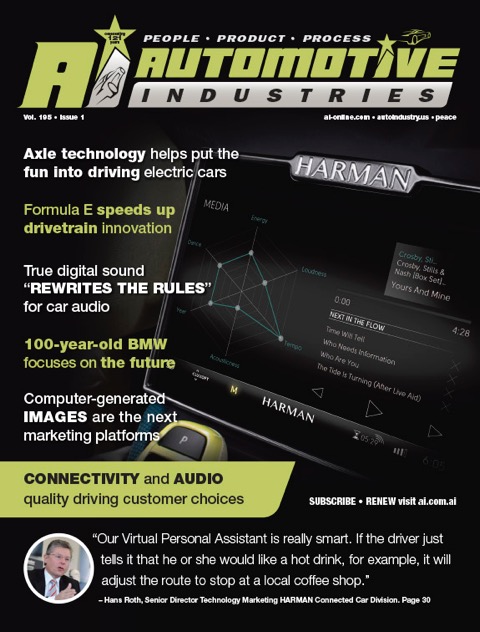
Both connectivity and audio quality are “trending” in the design studios of OEMs and their Tier suppliers. One of the leaders in both fields is Connecticut USA – based HARMAN International.
Automotive Industries (AI) asked Hans Roth, Senior Director Technology Marketing HARMAN Connected Car Division, what are the biggest challenges to achieve a truly connected car.
Roth: A truly connected car – one prerequisite for autonomous driving – needs optimal coverage as well as the right bandwidth and functionality in place to support communication. The challenge is that the standards, e.g. IEEE 802.11p for car-to-car communication, haven’t been finalized yet, while the technology is ready for implementation. This really takes an industry-wide effort. Our objective is to provide information in real time both to and from the car. One of the features of a truly connected car is that you utilize a cloud platform outside to receive vehicle data, to process it, and then send it back to the car and other connected devices in the vicinity. With the HARMAN Service Delivery Platform we are able to provide complete end-to-end solutions to supplement the navigation data, for example. Our SDP is also open to third parties. AI: What is the difference between simple navigation and intelligent navigation?
Roth: Conventional navigation starts from scratch every time. Learning navigation systems record the behavior and preferences of the driver and store the information both on board and in the cloud. This data is then analyzed to identify and select preferred routes. The system may also read the driver’s calendar so that they won’t need to enter the destination. Such convenient, predictive and learning functionality is one of the backbones of intelligent navigation of the future.
AI: How is your “defense-in-depth” security model changing the way to secure the connected car?
Roth: Best possible security is a prerequisite for all computing and communication both within the car and when it connects with the world – and even more so for the autonomous future. This starts with secure encryption technologies, followed by continuous OTA updates that keep all vehicle ECUs up to date over its lifetime. On the on-board application side you need several layers of security. That’s why we have developed our 5+1 security architecture that incorporates very strong systems to detect and prevent intrusions. Our recent acquisition of TowerSec, one of the world’s top specialists in the field of TCU and ECU protection, stresses the importance HARMAN places upon this topic.
AI: With the Rinspeed Etos you have developed an adaptive intelligent car with first Microsoft Office 365 implementation in the car. How does the digital assistant help the driver?
Roth: Our Virtual Personal Assistant is really smart. If the driver just tells it that he or she would like a hot drink, for example, it will adjust the route to stop at a local coffee shop. The driver is able to communicate in his or her own words such as “a coffee would be nice” or “I need an espresso.” Another example: If you want to set up a call while driving – just tell the PA. It checks your calendar, finds an appropriate timeslot and automatically dials the number. The car then switches to autonomous mode and even adjusts the route for uninterrupted reception.
AI: How does the vehicle recognize the occupants and configure different aspects of the driving experience?
Roth: In general any smart device can do the job: As a second step we use face, iris or fingerprint recognition to make sure that only authorized drivers can move the car. Synchronization of calendar entries and seamless continuity of music playback from the home to the car can either be cloud enabled or smart device based.
AI then asked John Fitzgerald, Senior VP and General Manager Car Audio HARMAN Lifestyle Audio to share the trends in the market.
Fitzgerald: One of the megatrends is the influx of millennium buyers into the marketplace today. These kids grew up with MP3 players, digital music in their hands, earbuds in their ears, so they want to listen to music at all times. Now 70% of those people will say that the main place where they listen to their music is in the car. Our challenge is: How to create compelling audio solutions for these Millenials coming to the marketplace? The purpose is to get them hooked on branded audio with the first car purchase. Once we have them we’ll get them on the next car and the next car, and the next car. So my goal is to train and create those audiophile consumers.
AI: Do you have a different approach / strategy for the different segments?
Fitzgerald: There are different strategies depending on the vehicle segment and the end consumers that we are targeting. For first-time buyers we want to provide that connective experience that the Millenials are used to. Our Voyager Drive solution is a great example of a very targeted application that does just that, with minimal impact on the vehicle – which also makes it very attractive to automakers. It still provides that premium branded audio experience, which is what we are famous for, but we are able to target it at a price point for the entry level market segment that in the past was not achievable.
AI: What does the new Summit Car Audio solution offer to the OEMs?
Fitzgerald: To the carmakers it offers upgradability, modularity and a scalable platform. It is powered by an industry-first System-On-Chip model that gives OEMs the freedom of a truly scalable system, with up to 10 times the signal processing capability of conventional amplifiers. Gone are the days when you’ve had to predict where the market is going to be in the next four years. Summit gives you relevant, up to date new modern technology, seamlessly upgradable and coupled with cutting edge expandable features at the time you launch your car, and throughout the lifecycle of the vehicle.
AI: And, in turn, what can the automakers give the consumers in terms of new and more personalized in-car experiences?
Fitzgerald: Summit really is the pinnacle of the in-vehicle audio listening experience. The technology and System-On- Chip amplifier model of our Summit solution work together to unlock an unprecedented, ever-expanding menu of new and more personalized in-car experiences. Summit’s technology offerings include a full complement of HARMAN’s proprietary next generation features, including Individual Sound Zones, Quantum Logic Immersion surround sound, Personal Bass Impact, Connected Juke Box, and Virtual Venues. By increasing the CPU power are able to offer all these features in one system.
AI: How does the Voyager Drive solution break the constraints of the traditional door speaker and head unit architectures?
Fitzgerald: Voyager Drive enables OEMs to bring true premium audio to the fast-growing – and previously untapped – entry vehicle segment. What’s more, Voyager Drive is completely transportable, seamlessly following you from your house, to your car, to the office, or wherever your journey takes you. A proprietary software solution from our partner Dirac, called Dirac Panorama, creates the sound of a truly branded premium audio experience – but from an array of speakers in the dash as opposed to speakers distributed throughout the car. It is very effective for the automakers because it eliminates all the complexity of multiple components – screws and gaskets, and brackets and harnesses.
AI: Where do you see the biggest growth opportunity for HARMAN?
Fitzgerald: It is a great time for automotive audio to grow through new product offerings targeting the Millennial customers entering the market. The technology advancement we bring to the table has already drawn a lot of interest from OEMs across the globe.
The cockpit of the Etos concept car.
AI














More Stories
LED Lighting for Heavy-Duty Applications: Durability, Efficiency, and Versatility
Celanese Materials Shine in Multiple Category Winners at 2024 SPE Automotive Innovation Awards
New future-ready single-slot PXIe controller for high-performance T&M applications from Pickering Interfaces